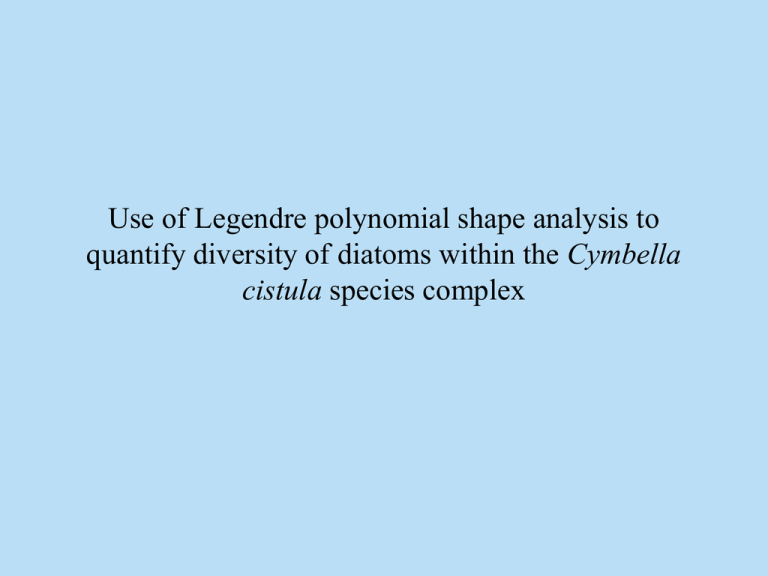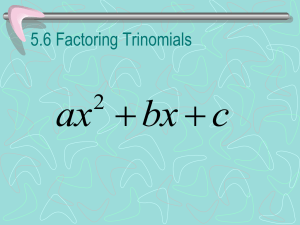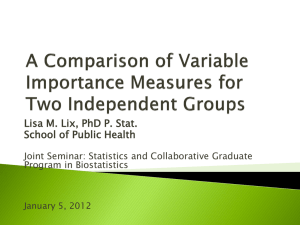Legendre shape analysis of specimens in the Cymbella
advertisement

Use of Legendre polynomial shape analysis to quantify diversity of diatoms within the Cymbella cistula species complex Examples of Cymbella cistula species complex Map showing Torch Lake and South Fox Island Ecology • Torch Lake and waters around South Fox Island - oligotrophic. • Cymbella cistula: – – – – – Alkaliphilous (pH 7) Tolerates small amounts of salt High concentration of inorganic nutrients Mostly characteristic of standing waters Found in lakes – Periphytic (grow attached to substrate by polysaccharide stalks) Why use diatom shape analysis? • Shape is an inherited characteristic of diatoms • Shape is the one of the primary morphological characters considered in diatom identification • Subtle changes in diatom shape are produced during size diminution via vegetative reproduction that may be detectable by shape analysis – Shape analysis is useful in determining diversity within a genus or species complex – Three taxa-- Cymbella cistula, C. cistula var. gibbosa and C. cistula var. truncata were originally identified in Lake Michigan (Stoermer and Yang 1969). Shape analysis using Legendre Polynomials 2 Laplace’s equation is u x2 2 + u y2 =0 Second order Elliptic (discriminant < 0) Has no discontinuities Laplace’s equation in rectilinear coordinates is separable. That is, the solution we are interested in finding to Laplace’s equation would be of the form where one side of the equation depends only on x and the other side depends only on y. The solution is a product of a function of x only and a function of y only u X xY y if and only if x and y satisfy for some cons tant . X X 0 Y Y 0 From Laplace' s equa tion in the fo rm of m 2 d 2 dPn x Pn x Pn x 0 1 x dx dx 1 x 2 where x cos and P cos on the interval 1 x 1. This is an eigenva lue problem with two singular endpo ints (a bounda ry value problem). For m = 0, we want to solve eigenfunctions in the form of d 2 dPn x 1 x Pn x 0 dx dx We wan t a solution in the neighborhood o f x = 1 as a power series in (x - 1) g iven by Pn x x 1 c x 1 k k k 0 Setting co effi cient c k to ze ro results in the recu rsion formula c k 1 k k 1 c 2k 1 2 k and by the ratio test, ck x 1 converges for x 1 2. k Becaus e of recu rsion, n n n 1 wheren = 0, 1, ... if and onlyPifn x is bounded by -1 <x < 1. Correspond ing to n with c 0 1, Pn x is n k! x 1 k 2 k k 0 n k !k! 2 n Pn x which is defined as a Legendre polynomial of degree n in x with density function x 1. The eigenvalues, n , are non-negative numbers. Theorthogonality condition is met since 1 P xP x dx 0 m n 1 for m n. T he first twoLegendre polynom ials are defined P as0 x 1 and P1 x x . Each successivent h degreeLegendre polynom ial may be calculat ed as Pn x 2n 1 n 1 x Pn1x Pn2 x n n In shape analysis, a width fun ction, W(x), is defi ned a s N W x bn Pn x n 0 where bn represents n-Legend re co effi cients from expan sion of the width function. • The width function is a linear combination of Legendre polynomials of degree n in x (orthogonal polynomial regression). • Legendre coefficients serve as shape descriptors. Legend re co effi cients calculated in matrix algebr aic form, b, are b = Pn x † Pn x -1 Pn x † y Reconstruction of the diatom outline x= n 2n - 1 Pn + 2 x + n - 1 Pn x n Pn + 1 x where n = 0, 1, 2, ..., and n y =b- • k =1 where b is the intercept or mean coefficient. bk, 1 Pn , k x Using the width function Find equidistant x-coordinates between -1, 1 for the top half. Flip the bottom half on the horizontal, and find equidistant x-coordinates between -1, 1 for the bottom half. whole outline Perpendiculars from the coordinates indicate the width found by the width function for the top half. Perpendiculars from the coordinates indicate the width found by the width function for the bottom half. Materials • 66 specimens were used in shape analysis; (they were flat and without distortion to the valve face). • Post-auxospore populations were present on slides with specimens around South Fox Island. • From Torch Lake, the smallest specimens were 30% smaller than the longest specimens. Methods • Microscopy and digitization of specimens 1000X magnification (oil immersion) 1.32 numerical aperture • NIH Image software (version 1.62) • 50 equidistant x-coordinates chosen for each half of outline to calculate Legendre polynomials and coefficients • Data analysis PCA of shape coefficients for entire outline PCA of shape coefficients for dorsal side of outline Discriminant analysis of shape coefficients- dorsal side of outline Results • The first 10 shape coefficients were sufficient to reconstruct outlines • First PCA eigenvalues: 0.948, 0.36, 0.006, and 0.003 • Second PCA eigenvalues: 0.99, 0.004, 0.003, and 0.002 • Nine shape groups • Discriminant analysis eigenvalues: 0.913, 0.667, 0.404, and 0.343 – Canonical correlation coefficients were 0.956, 0.816, 0.636, 0.585 – Wilks’ lambda=0.0079, F-stat=4.48 First PCA Second PCA Second PCA with shape groups circumscribed Representative specimens for each shape group Shape group 5 Shape group 1 Shape group 6 Shape group 2 Shape group 7 Shape group 3 Shape group 8 Shape group 4 Shape group 9 Shape groups and taxonomic identifications • Shape group 1: Cymbella cistula var.truncata • Shape group 2: C. neocistula var. islandica • Shape group 3: C. cursiformis, C. cymbiformis var. nonpunctata, C. neocistula var. lunata • Shape groups 4 and 5: C. cistula (Krammer & Lange-Bertalot (1986)) and C. neocistula (Krammer 2002) • Shape groups 6, 7, 8, and 9: C. cistula var. gibbosa Distribution of specimens • Shape group 1: South Fox Island (Cymbella cistula var.truncata) • Shape group 2: Torch Lake (C. neocistula var. islandica) • Shape groups 3, 4 and 5: All but 3 specimens from South Fox Island (C. cursiformis, C. cymbiformis var. nonpunctata, C. neocistula var. lunata, C. cistula (Krammer & Lange-Bertalot (1986)) and C. neocistula (Krammer 2002)) • Shape groups 6 and 7: Mix of specimens from both areas (C. cistula var. gibbosa) • Shape groups 8 and 9: All but one specimen from South Fox Island (C. cistula var. gibbosa) Discriminant analysis Monte Carlo permutation test 99 permutations (full model) 1st canonical axis: P-value = 0.10 F-ratio = 7.09 Trace=2.66 P-value = 0.10 F-ratio = 2.74 Number of correct assignments for each shape group from discriminant analysis. shape shape shape shape shape shape shape shape shape group group group group group group group group group 1 2 3 4 5 6 7 8 9 _______________________________________________________________________ shape group 12 0 1 0 0 0 0 0 0 1 shape group 0 3 0 0 0 0 0 0 0 2 shape group 1 0 7 3 0 0 0 0 0 3 shape group 0 0 1 7 0 0 0 0 0 4 shape group 0 0 0 0 5 1 0 0 0 5 shape group 0 0 0 0 0 6 2 0 0 6 shape group 0 0 0 0 0 0 5 1 0 7 shape group 0 0 0 0 1 0 1 4 1 8 shape group 0 0 0 0 0 0 0 0 4 9 Total 13 3 11 8 6 8 6 7 4 Relation between Legendre coefficients and qualitative shape descriptors • Shape coefficients 4 through 7 were highly correlated with the first canonical eigenvector in discriminant analysis. • The zeroth and first shape coefficients represented initial semicircularity in shape without expansion of the mid-valve region. • Addition of the fourth shape coefficient represented lunateness (including crescenticness, arcuateness, and semilancelateness)--defines shape dorsally in a global sense. • Addition of the sixth coefficient defined expansion of the mid-valve region (i.e., degree of gibbousness). • Shape coefficient 8 was highly correlated with the second canonical eigenvector in discriminant analysis. With the addition of this coefficient, Cymbella shape was well-defined with shape differentiation evident in the mid-valve region ventrally. Partial curve reconstructions with respect to number of coefficients used addition of the sixth coefficient (b0, b1, b2, b3, b4, b5, and b5) addition of the fifth coefficient (b0, b1, b2, b3, b4, and b5) addition of the fourth coefficient (b0, b1, b2, b3, and b4) addition of the third coefficient (b0, b1, b2, and b3) addition of the second coefficient (b0, b1 and b2) curve reconstruction using the first two coefficients (b0 and b1) Implications and Inferences • Shape analysis was useful in showing that more taxa were present than was found originally-- more diversity. • Cymbella cistula species complex consists of at least five and as many as seven different taxa present. • Shape space in 2nd PCA indicated a shift from simple (shape group 1) to more complex shapes (shape groups 6-9). • Shape differences between groups may indicate developmental differences in that shape groups may represent ontogenetic trajectories. Questions • Differences between Torch Lake and waters around South Fox Island? • Is there greater diversity within other genera present? • If so, what does this indicate about microhabitats and environmental conditions? • What are the implications of stability with respect to diversity in microhabitats-- local and global time scales? • How can microhabitat diversity be useful, viz., identifying small but important changes in habitat?











